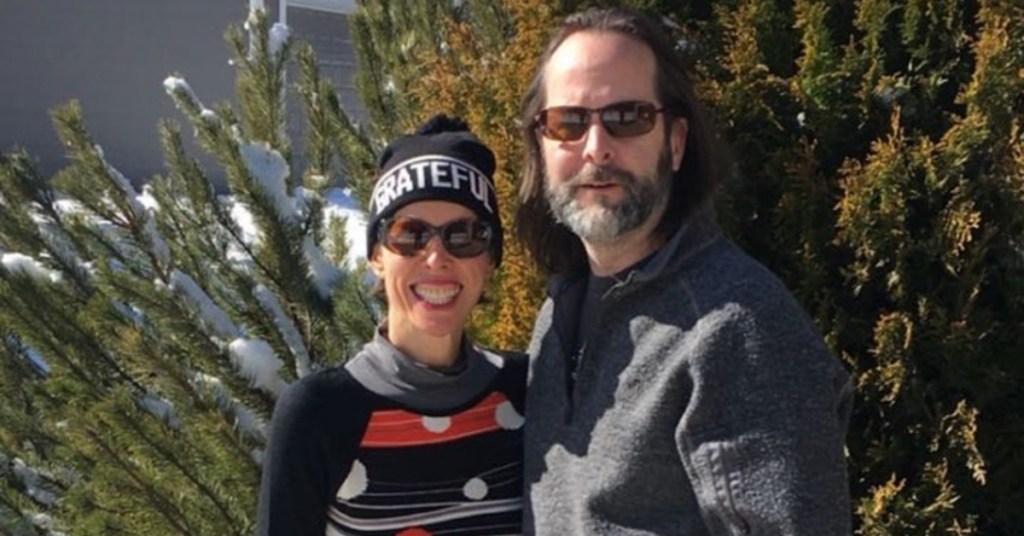
Before discovering she had a benign brain tumor, Taylor Gregg was in a state of constant confusion and frustration about what had happened to her. Over the course of a few short years, her physical mobility had decreased to the point that walking around her house was an arduous challenge. Additionally, her cognition and memory had diminished significantly, leaving her unable to work. By the time her brain tumor was discovered, she couldn’t even remember the previous two years of her life.
Looking back, she recalls the intense fear she felt about the possibility of being a burden on her family for the rest of her life. Her previously optimistic worldviews had given way to deep frustration, and she didn’t have any clear answers about what had happened to her.
Although she didn’t fully realize it at the time, the traumatic transformation she experienced underlined a serious imbalance in the way she had been living. It also prompted her to deeply examine her life and values, and to discover a path that wouldn’t just help her to recover, but one that would allow her to experience more joy, vitality, and abundance than she ever imagined was possible.
Meet Taylor: A Caring, Success Driven Young Woman
For over three decades, Taylor Gregg’s life was largely defined by ambition, focus, and commitment to her aspirations. Even as a three-year-old toddler, she emanated a fiery enthusiasm that provided energy and poise in her earliest competitive endeavor: gymnastics. From a young age, Taylor valued experiences that allowed her to explore and cultivate a deep connection to her body. Anyone who has practiced gymnastics knows that it challenges you in strength, flexibility, balance, and focus. For many, it really is a metaphor for the emotional qualities that help one to grow and succeed.
She also loved striving toward her goals and doing her very best! Gymnastics allowed Taylor to direct her full energy (Qi) towards something she cared deeply about. Although there’s great wisdom in dedication and focus, there were also some early signs that her single-minded directedness could lead her to undermine her own personal needs. On one occasion, she recalls succumbing to pressure to keep practicing after shattering her knee.
As a young adult, Taylor continued to channel her passion for movement by becoming a fitness instructor. To her, it felt like such a gift to be able to help people connect with their body and experience the beauty of physical exercise.
Realizing that she loved helping people while pursuing ambitious goals, Taylor entered another line of work that allowed her to aid others with some of their most core life-desires. She entered the matchmaking industry.
At the time, there was no such thing as dating apps or websites, so matchmaking coaches were in high demand. Seeing the opportunity to help people and build a successful business, Taylor charged full steam ahead to reach as many people as possible and positively affect their lives.
In many ways, she found her career path to be deeply fulfilling. She quickly saw that she could really help people in a deep and meaningful way, and her inspiration fed off of the success that she and her clients experienced together. However, as you might imagine, her position required her to hold space for individuals who were going through difficult times and sought support. Anyone who’s a therapist, medical professional, or coach knows that one of the greatest challenges of serving others can be keeping your own energy and emotions intact.
As empathetic creatures, humans naturally take on the states of consciousness of those they spend time with. Even just a few emotionally rigorous conversations can be draining, and the intensity and duration of Taylor’s work days meant that she was constantly a guide, sounding board, and pillar of strength for those around her. Basically, Taylor sacrificed her own needs in the pursuit of helping others and achieving success. By age 29, her net worth was over a million dollars, but her body and mind were slowly corroding without her knowing.
The Onset of Brain Tumor Symptoms
Around 2014 or 2015, things started to change for Taylor. At first, she experienced vertigo and began falling down occasionally. As a previously active and energetic person, this was completely new to her and caused her and her husband to worry. So she saw her doctor, but they didn’t have any answers for her. Not only that, but her doctor told her that her symptoms were “all in her head” (and not in the way of having a brain tumor). If a doctor has ever told you that “you’re fine” when you’re not, you know how discouraging it can be to feel like the medical system is invalidating your own experience of your body!
Despite her doctors’ reassurances of her good health, Taylor’s symptoms persisted, and eventually got worse. She gained some weight, lost more physical mobility, and suffered from lack of consciousness and awareness. Her husband later reflected that by 2017 she was walking like an unhealthy ninety-year-old. He continued to help her in every way he could, and also felt that he had lost the woman he fell in love with. Still, there were no answers to her condition.
Not only was Taylor physically debilitated, but she was confused and her mind was experiencing some alarming symptoms as well. Her sharpness decreased and her memory diminished. After her eventual recovery, she would come to realize that she had absolutely no recollection of the last two years of her life from 2017 and 2018. Additionally, her inner struggles were reflected in the collapse of her external world — she lost her business and her personal finances suffered dramatically.
Taylor’s Path of Recovery
Finally, things came to a tipping point. One day, Taylor’s husband came home and found her laying on the ground with her head stuck between the bed and night stand. After freeing her, he rushed her to the emergency room where she received a brain scan. The scan showed a benign tumor growing in her head.
Soon after, Taylor underwent surgery to have it removed. Even though she was relieved to have answers, it was clear that she faced a long recovery process ahead of her.
To continue his supportive role, Taylor’s husband told her to not even think about work or finances and to focus 100% on her own recovery process. Knowing that the rest of her life laid in the balance, Taylor accepted his request and set forth on a journey of healing and personal exploration.
So, where to start? In addition to doing research, Taylor reflected on the lessons and experiences she had encountered throughout her life in the hope of finding a thread of guidance.
One memory stuck out to her: sometime during her twenties she’d dabbled in a martial practice she recalled as “Qi Gong.” She remembered that the teacher’s name was Lee and that he appeared on PBS television.
Back then, during her fast-paced fitness training days, Qi Gong had seemed too slow and “simple” for her. After all, how many calories could you possibly burn meditating compared to sprinting five miles and doing a high speed weight lifting workout? Twenty-five-year-old Taylor had no time for slow moving spiritual practices!
Now, in her immediate post surgery bedridden state, Qi Gong seemed perfect! Cautious to avoid overworking herself, Taylor started her Qi Gong path by doing easy, 7-minute routines.
Taylor immediately realized that Qi Gong held something special. She saw that it allowed her to relate to her body and mind in a way that her fast paced, outward-focused life was completely unfamiliar with. She could feel her internal energy coming alive and flowing throughout her. She could atune herself to her own personal needs rather than dweling on what was happening with those around her. Simply put, Qi Gong showed her a completely new perspective of the world that was deeply nourishing.
Soon, seven minutes per day turned into ten minutes, which turned into 20, and then into 30. For months, her biggest accomplishments were learning how to walk a few extra steps. Her husband placed chairs all around their house so she could stop and rest whenever she needed to. Over time, Taylor decided she was ready to take on new ambitions, like washing dishes or folding laundry. However, this time she knew that her focus needed to be on enjoying and thriving throughout the activities she experienced, rather than solely orienting her priorities around the outcome she was working towards.
In addition to her physical growth, Taylor also discovered an entirely different way to experience herself and the world that surrounded her. Qi Gong taught her to be aware of her body and mind in each moment, and to cherish the internal gifts that she was blessed with. No longer was sweeping the floor a menial task, but an inspiring reminder of her physical gifts and ability to contribute to her family. Long before she reached a full physical recovery, she viewed her body with more love and appreciation than she had ever felt toward herself before.
Throughout her recovery process, Qi Gong continued to be a cornerstone of her daily living. Soon enough, 30-minutes no longer felt effortful, so she found more routines that served her and practiced longer. She explored several teachers’ lessons, including Lee’s, and continued to find great value in his training. Taylor also walked a little further each day; within four to five months she was up to doing close to three-mile hikes every day. By all measures, she was flourishing.
Taylor’s Path Forward
It’s been a little over twelve months since her surgery and Taylor feels she couldn’t be more grateful for what she’s learned throughout her recovery process. In her own words, “I know in my body, mind and spirit that I am here today by the grace of God. Everything happens for a reason and the reason is for good. God is sooo good.”
Today, she wakes up each morning at 5am to practice Qi Gong for an hour-and-a-half before going about her day. Another hour-long session follows later in the afternoon, bringing her daily average to about two-and-a-half hours. To her, it doesn’t even feel like an effort to practice so much; it feels enjoyable and nourishing. She’s even a little disappointed when she reaches the end of a long practice session.
Moving forward, Taylor is dedicated to helping people experience health and happiness by cultivating a strong and loving connection with themselves. She recognizes that no external ambitions or passions can override one’s own personal needs, and wants to help others who may be experiencing the same pattern of self-neglect that she fell into. At this point, she’s not exactly sure what form her passion for helping others will take, but her ideas are brewing. Writing a book is among her thoughts!
At Holden QiGong, we feel excited and honored to be a part of Taylor’s healing journey and look forward to watching her grow!
